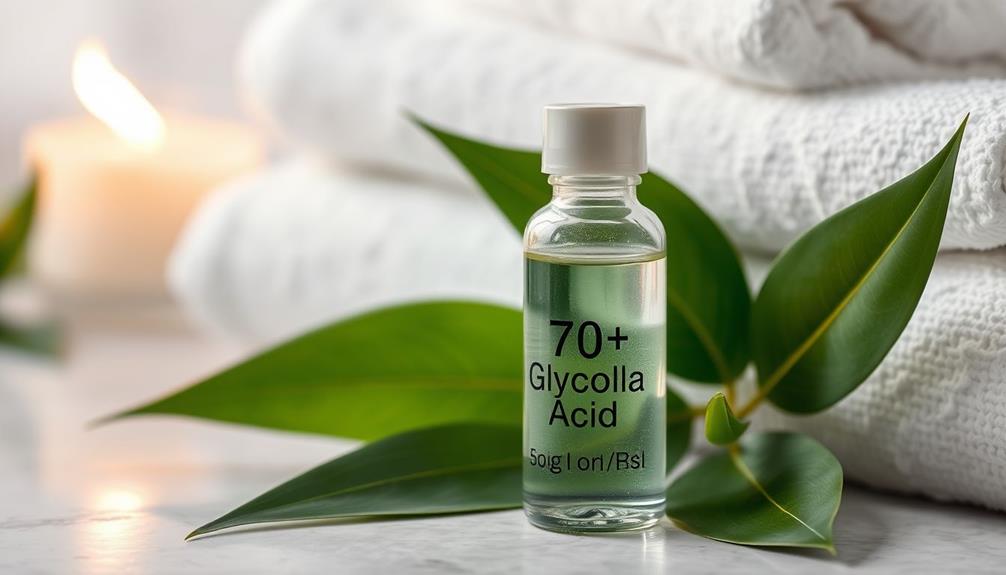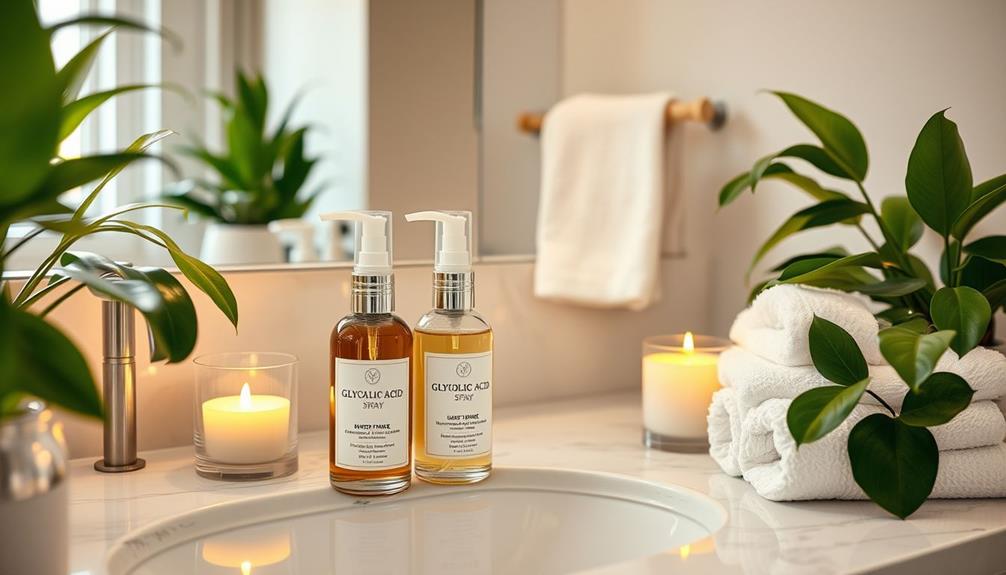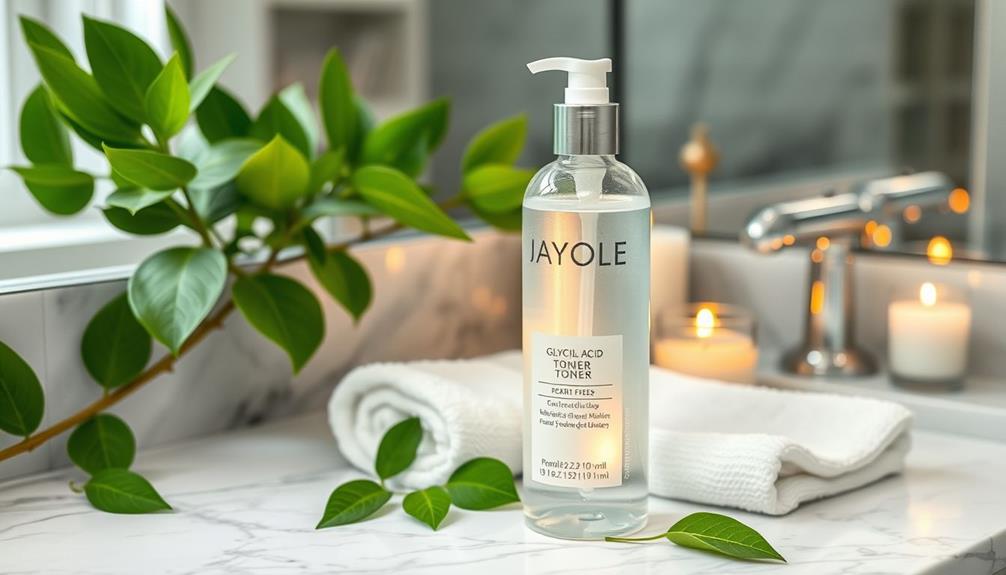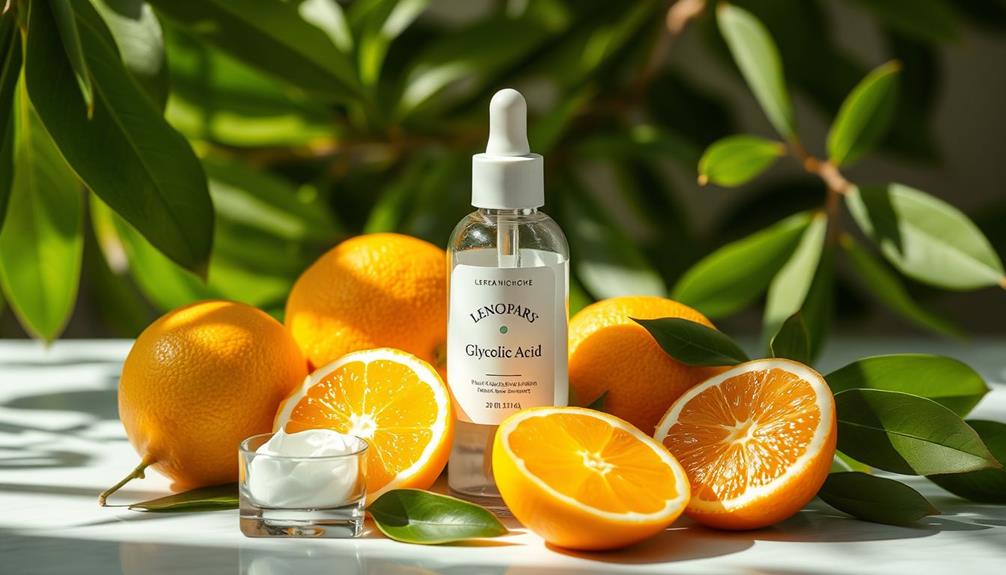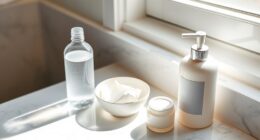The 70% glycolic acid peel can be worth it if you're looking to address advanced skin issues like wrinkles, hyperpigmentation, and acne scars. It penetrates deeply, enhances cell turnover, and stimulates collagen production, resulting in smoother, more radiant skin. However, you should be aware of potential side effects, such as redness and peeling. Ideal candidates include those with normal to dry skin who can commit to regular treatments every 4-6 weeks. If you're curious about the treatment process and aftercare tips, there's more to explore that could help you make an informed decision.
Key Takeaways
- The 70% glycolic acid peel effectively addresses advanced skin concerns like wrinkles, hyperpigmentation, and acne scars, offering noticeable improvements.
- Regular treatments every 4-6 weeks lead to enhanced skin texture, firmness, and a radiant complexion.
- It accelerates cell turnover, helping diminish hyperpigmentation and achieve a more uniform skin tone.
- Increased collagen production results in firmer skin and reduced visibility of fine lines and wrinkles.
Overview of Glycolic Acid Peels

Glycolic acid peels, especially at a 70% concentration, provide an effective solution for tackling advanced skin issues like wrinkles, hyperpigmentation, and acne scars.
As a potent chemical exfoliant, glycolic acid penetrates deeply into the skin due to its small molecular structure, enhancing cell turnover and stimulating collagen production. This makes it a valuable option if you're dealing with stubborn skin concerns that require a more intensive approach.
Additionally, incorporating aromatic oils for relaxation can enhance your overall skincare experience by reducing stress and promoting a sense of well-being during your treatment.
Before undergoing a glycolic acid peel, you'll typically need a prep phase that includes using an exfoliator and conducting patch tests to verify your skin can handle the treatment.
Sessions are usually recommended every 4-6 weeks for the best results.
While many users report significant improvements in skin texture and tone, it's important to be aware of potential side effects.
After the peel, you might experience redness, peeling, and increased sensitivity.
To promote healing, proper aftercare is vital, including moisturizing and sun protection.
Benefits of 70% Glycolic Acid
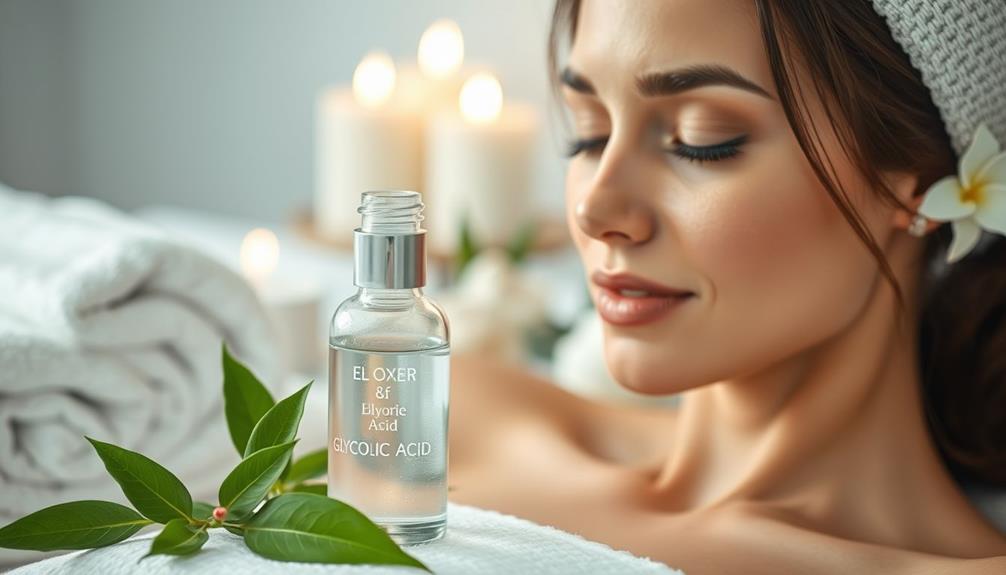
Using a 70% Glycolic Acid Peel can greatly enhance your skin texture by sloughing off dead cells and revealing a smoother surface.
This chemical exfoliation process can be complemented by aromatherapy techniques that promote relaxation and enhance the overall experience.
You'll notice diminished hyperpigmentation and an overall more even skin tone, which helps boost your confidence.
Plus, it stimulates collagen production, giving your skin that youthful firmness and elasticity you desire.
Enhanced Skin Texture
Achieving enhanced skin texture is a key benefit of the 70% Glycolic Acid Peel, as it promotes cell turnover for smoother and more radiant skin. This powerful chemical exfoliant effectively targets dead skin cells, leaving your complexion revitalized. If you're struggling with signs of aging or dullness, this peel could be your solution. Additionally, incorporating practices like body awareness techniques can complement your skincare routine by enhancing overall wellness and promoting a healthy glow.
Here are some benefits you can expect:
- Smoother Skin: By removing dead skin cells, the Glycolic Acid Peel reveals a softer, more even surface.
- Improved Firmness: The peel stimulates collagen production, enhancing skin elasticity and firmness.
- Radiant Complexion: Regular use can lead to a brighter, more luminous skin tone as it helps to reduce dullness.
- Long-lasting Effects: With consistent treatments every 4-6 weeks, you'll notice cumulative improvements in your skin texture.
Incorporating the 70% Glycolic Acid Peel into your skincare routine not only addresses the immediate concerns of texture but also works to diminish the overall appearance of aging over time. If you're ready for a glow-up, this peel may be worth considering.
Diminished Hyperpigmentation
The 70% Glycolic Acid Peel effectively diminishes hyperpigmentation by accelerating cell turnover and revealing a more uniform complexion.
This powerful chemical peel works by removing discolored skin cells, allowing fresh, healthy skin to surface. If you struggle with age spots, sunspots, or melasma, glycolic acid can considerably reduce their appearance, leading to a brighter skin tone.
Additionally, the wisdom-infused quotes from literature emphasize the importance of self-care in enhancing one's beauty and confidence, reflecting the transformative effects of such treatments wisdom-infused quotes.
Clinical studies support the effectiveness of glycolic acid in targeting stubborn hyperpigmentation at a cellular level. Its small molecular size allows it to penetrate deeply, ensuring that the treatment reaches the underlying pigmentation.
Regular use of the 70% peel can lead to cumulative improvements, with users often noticing a marked reduction in dark patches after multiple sessions.
With proper application and post-treatment care, this peel comes with minimal downtime, making it suitable for experienced users looking to address considerable hyperpigmentation concerns.
By incorporating the 70% Glycolic Acid Peel into your skincare routine, you can achieve clearer, more even skin, ultimately enhancing your overall appearance.
If you're ready for a more radiant complexion, this peel could be the solution you've been searching for.
Increased Collagen Production
Boosting collagen production is one of the key benefits of the 70% Glycolic Acid Peel, helping you maintain skin elasticity and firmness while effectively reducing signs of aging. When you undergo this treatment, you're not just exfoliating your skin; you're actively stimulating your skin's natural processes, leading to remarkable effects.
Here are some benefits you can expect:
- Increased Collagen Production: The peel enhances fibroblast activity, promoting collagen synthesis.
- Improved Skin Elasticity: Higher collagen levels contribute to a firmer, more resilient skin texture.
- Diminished Fine Lines: As collagen increases, you'll notice a reduction in the visibility of fine lines and wrinkles.
- Youthful Complexion: With consistent treatments, you can achieve a plumper, healthier look, revitalizing your skin.
Regular use of the 70% Glycolic Acid Peel can lead to cumulative benefits, making it an effective option for advanced skin rejuvenation.
Clinical studies show that this high concentration yields pronounced increases in collagen production compared to lower concentrations.
Ideal Candidates for the Peel

For those experienced with chemical exfoliation, the 70% Glycolic Acid Peel offers significant benefits, particularly for individuals dealing with advanced skin concerns. Ideal candidates typically have normal to dry skin types and have previously used lower concentrations of glycolic acid peels. This peel is designed to address issues like lines, wrinkles, age spots, adult acne, and hyperpigmentation.
Here's a quick overview of ideal candidates for the 70% Glycolic Acid Peel:
| Criteria | Details |
|---|---|
| Skin Types | Normal to Dry |
| Fitzpatrick Types | I to III (Lighter Skin Tones) |
| Skin Concerns | Advanced issues like wrinkles, acne |
It's crucial to note that those with sensitive or oily skin may experience significant dryness or irritation. Additionally, prepare for some moderate downtime, as visible peeling is likely. Following specific pre-treatment instructions will guarantee you achieve the best possible results from the 70% Glycolic Acid Peel. If you fit these criteria, you could benefit greatly from this powerful chemical peel.
Application Process and Guidelines
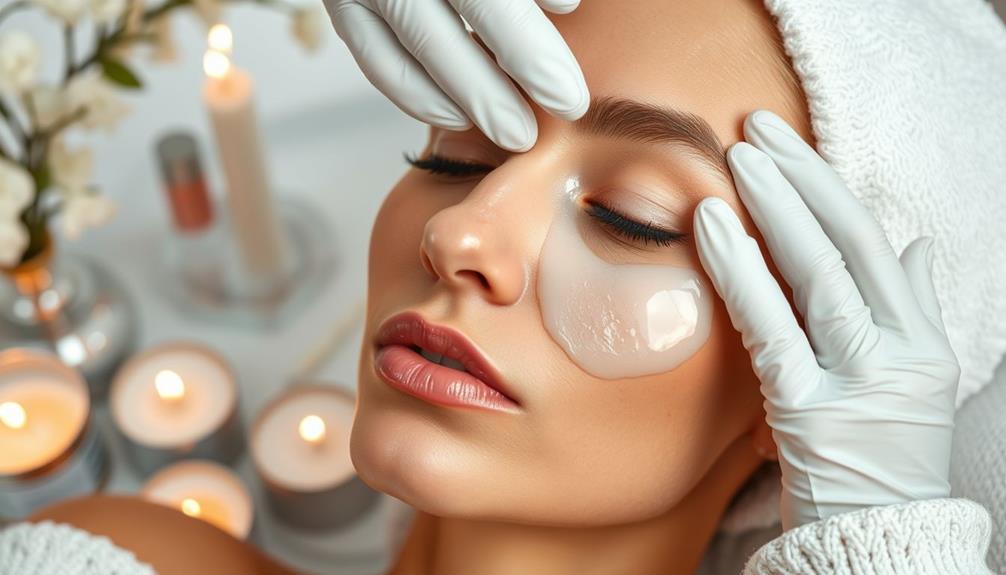
Before applying the 70% Glycolic Acid Peel, you'll need to prep your skin properly to guarantee the best results.
This includes following specific steps before and after the peel for ideal care.
Let's go over the essential preparations and post-peel tips you should keep in mind.
Pre-Application Preparation Steps
Preparing your skin for a 70% Glycolic Acid Peel starts with using an exfoliator, like a Glycolic 10% Daily Exfoliator, for a week prior to the treatment. This preparation helps loosen dead skin cells and enhances the peel's effectiveness. To guarantee a smooth application, follow these steps:
- Exfoliate: Use an exfoliator daily for one week leading up to the peel.
- Patch Test: Conduct a patch test three days before the treatment to ensure your skin can tolerate glycolic acid without adverse reactions.
- Cleanse: On the day of the peel, cleanse your skin thoroughly to remove any impurities, oils, or makeup.
- Neutralize: After the peel, use a Chemical Peel Neutralizer and rinse with water to halt the effects of the acid.
Post-Peel Care Tips
After completing your 70% Glycolic Acid Peel, prioritizing proper post-peel care is key to achieving the best results and maintaining healthy skin.
Start by rinsing off the peel, then immediately moisturize your skin with products containing ceramides, hyaluronic acid, or peptides. This helps restore hydration and supports your skin barrier.
Don't forget that glycolic acid increases skin sensitivity, making it essential to apply sunscreen daily. Your skin will be more vulnerable to UV rays, so choose a broad-spectrum sunscreen with at least SPF 30 and reapply throughout the day.
Avoid introducing other strong treatments, like retinoids or exfoliating products, right after the peel. This prevents irritation and allows your skin the time it needs to recover.
Keep an eye on your skin for any adverse reactions, such as excessive redness or irritation. If you notice severe symptoms, consult a dermatologist for guidance.
Potential Side Effects to Consider
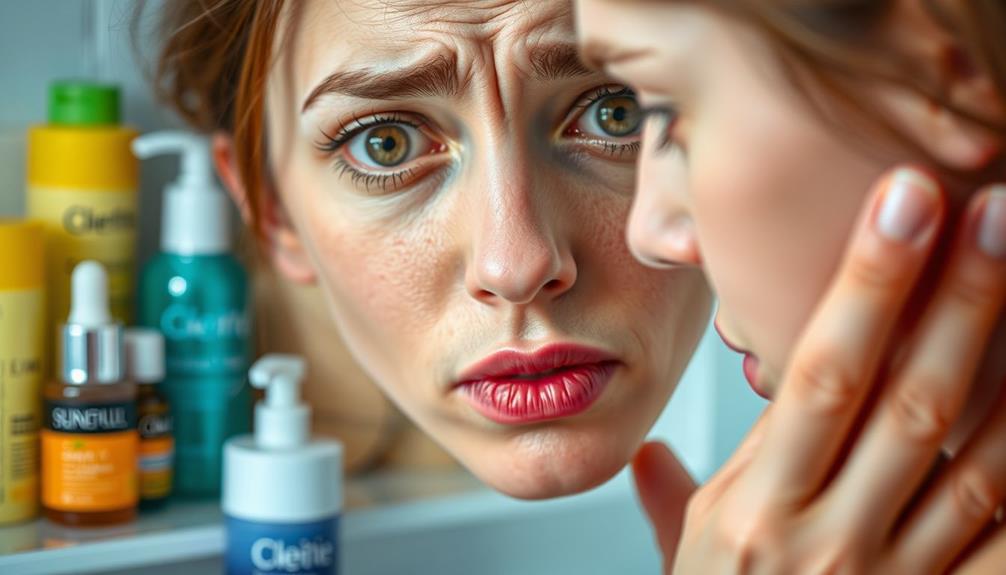
Considering a 70% Glycolic Acid Peel? Be aware that common side effects include redness, dryness, and peeling, which can last five to seven days post-treatment. You should also consider other potential issues that might arise from this strong peel. Here's a quick breakdown:
- Redness: Your skin may appear flushed immediately after the treatment, indicating its reaction to the acid.
- Dryness: You might experience tightness and dryness as your skin adjusts, leading to a need for additional moisturization.
- Peeling: As dead skin cells shed, expect noticeable peeling, which is part of the exfoliation process.
- Sensitivity: Increased sensitivity to sunlight is a significant concern, so applying sunscreen is essential to avoid further irritation or hyperpigmentation.
Additionally, deeper peels like this one can pose risks of infection or scarring, especially if you have sensitive or darker skin tones.
To minimize side effects, it's important to do a patch test three days before your peel and avoid strong treatments right after. Being informed will help you navigate your post-peel experience more smoothly.
Aftercare and Recovery Tips

To guarantee your skin heals properly after a 70% Glycolic Acid Peel, focus on hydration and gentle care in your post-treatment routine.
Start by applying a high-quality moisturizer that contains ceramides, hyaluronic acid, or peptides to restore moisture and support your skin barrier. This is vital, as your skin might experience increased sensitivity due to the glycolic acid.
Make certain to apply sunscreen diligently for at least two weeks after the peel. The glycolic acid will heighten your skin sensitivity to UV rays, so protecting your skin from potential hyperpigmentation is essential.
Avoid using strong treatments like retinoids or exfoliants during the first week post-peel to prevent irritation and allow for proper recovery.
Keep monitoring your skin for any adverse reactions, such as excessive redness or peeling. If you experience severe side effects, don't hesitate to consult a dermatologist.
Finally, stick to a regular skincare routine that includes gentle cleansers and moisturizers to maximize your results and promote overall skin health after the peel.
Following these aftercare tips will help guarantee your skin heals beautifully.
Comparing Professional Vs. At-Home Peels
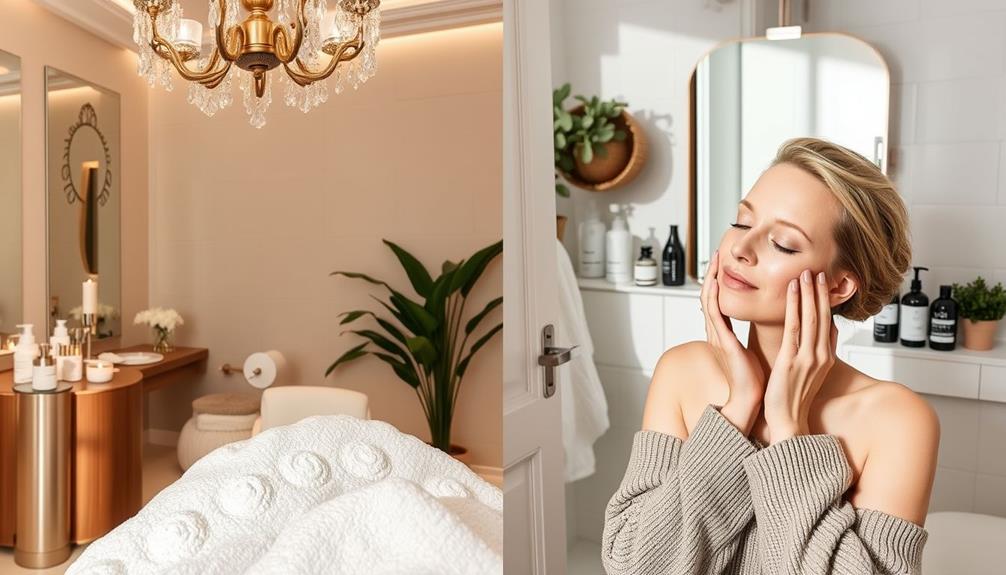
When weighing the benefits of professional versus at-home glycolic acid peels, you'll find each option has its unique advantages and drawbacks. Understanding these differences can help you make an informed decision for your skin care routine.
- Concentration: Professional peels typically use 30-40% glycolic acid, allowing for deeper penetration, while at-home peels often feature lower concentrations, like the 70% glycolic acid peel designed for experienced users.
- Results: In-office treatments provide immediate, visible results with minimal downtime. At-home peels may yield milder effects due to the user-controlled application time and frequency.
- Personalization: Professional peels are administered by licensed dermatologists who can tailor the treatment to your specific skin concerns. In contrast, at-home peels lack this personalized assessment.
- Cost: At-home glycolic acid peels are more affordable, averaging around $21.95, compared to professional treatments that can range from $80 to $200 per session.
Ultimately, whether you choose professional or at-home peels depends on your budget, skin type, and desired results. Make sure to weigh these factors carefully before proceeding!
Long-Term Skin Care Strategy
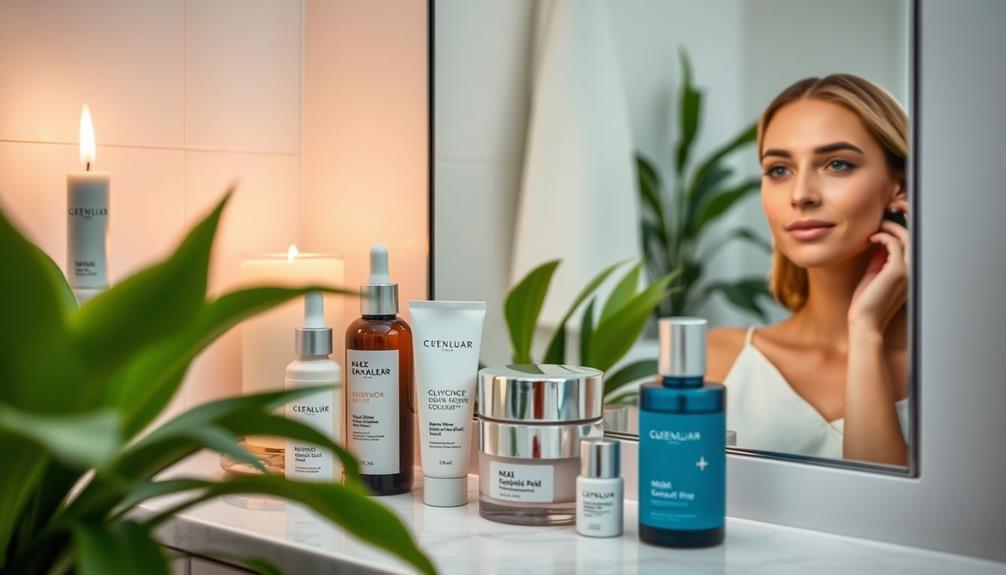
Developing a long-term skin care strategy that incorporates regular glycolic acid peels can greatly enhance your skin's texture and tone. To maintain those benefits, consider scheduling your chemical peels every 4-6 weeks. This routine helps to prevent clogged pores and signs of aging while keeping your skin looking fresh.
Here's a simple table to guide you through essential components of your strategy:
| Component | Details |
|---|---|
| Frequency of Peels | Every 4-6 weeks |
| Post-Peel Care | Use hydrating ingredients like ceramides |
| Sunscreen | Apply broad-spectrum sunscreen daily |
| Monitor Reactions | Adjust treatment based on skin tolerance |
| Consult a Dermatologist | Regular check-ins for personalized advice |
Post-peel care is vital; incorporating hydrating products enhances moisture retention and supports recovery. Since glycolic acid can increase sensitivity to sunlight, diligent sun protection is necessary. Keep an eye on your skin's reactions to prevent over-exfoliation and guarantee peak health. Regular consultations with a dermatologist can help you refine your long-term skin care plan, maximizing the benefits of your glycolic acid treatments.
Conclusion
To sum up, a 70% glycolic acid peel can be like an invigorating rain shower for your skin, revealing a brighter and smoother complexion.
If you're a good candidate and follow the application guidelines, it can work wonders.
Just be mindful of potential side effects and commit to aftercare for the best results.
Whether you choose a professional treatment or an at-home option, incorporating this peel into your long-term skin care strategy could lead to stunning improvements.
